This post contains affiliate links, meaning I get a commission if you decide to make a purchase through my links, at no extra cost to you. Please read my disclosure and privacy & terms for more info.
It’s tick season! As the weather is warming up, more and more people are heading outside. Travel trailers and motorhomes are finally out of storage, dewinterized, and ready for some summer adventures!
Although bonfires, delicious food, and great times are on your mind, it’s important to not overlook this tiny, eight-legged arachnid!
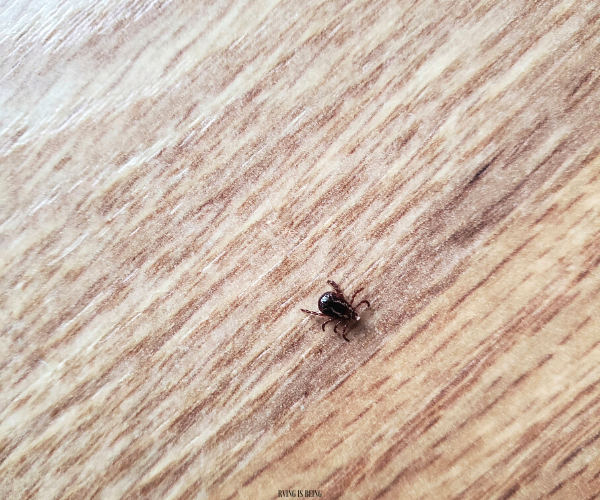
Ticks are not only another camp nuisance among their mosquito and spider pals, but can be quite the threat to campers due to the diseases they can carry. Although many tick bites are harmless, some can transmit pathogens known to cause that notorious Lyme Disease, which is steadily on the rise. Not only that, but Rocky Mountain Spotted Fever, Tularemia, and Ehrlichiosis are a few other diseases that can be transmitted by infected ticks.
While you shouldn’t cut your camping vacation short due to these creepy-crawly critters, you should take a few precautions for your health.
Preventing Ticks During Camping
Unfortunately, there’s no getting rid of ticks. However, it can be a tad bit easier preventing ticks around your home by keeping your lawn tidy, spreading tick control and using tick tubes.
Apart from home, how do you control ticks at the campsite when you’re literally, smack-dab in the middle of Tick Paradise?!
Unless you rent a seasonal site (where you could get away with using certain home defense remedies all season), it can be difficult to prevent these pesky parasites from outnumbering you when camping.
Tick Control Around the Camper
While it seems unfeasible to steer clear from tick environments while enjoying the great outdoors, you can try to select places that ticks may be less likely to reside in. Now, you’ll find ticks everywhere— even in your own backyard. However, ticks like shrubbery, long grass, fallen leaves, brush, and wooded areas. They can be less abundant in well-manicured areas with routine landscaping.

If you love camping but find yourself ticked-off over those pesky things– look for campgrounds with well-groomed grounds and routine lawn care. Try to set-up camp in a cleared area and stay away from wooded areas where brush or grasses are terribly overgrown.
After all, even at an upscale, urban resort with sparse trees and weekly mowing, there’s still no escaping them. That’s why it’s extremely important to step your game up when it comes to preventing bites.
Navigating the Campground
Try to avoid tick neighborhoods:
- Stick to well-groomed, cleared trails.
- Walk in the center of walkways or hiking paths to avoid brushing against tall grass.
- Try to prevent children or pets from sitting on the ground for long periods, running through overgrown areas, or playing in fallen leaves.
- Always bring camp chairs to keep you and your family up and off the ground.

Dress to NOT Impress
- Without risking overheating, wear long clothing that covers your arms and legs. (Light colored clothing can help keep you cool while making ticks easier to spot.)
- Tuck it in! To avoid ticks from crawling beneath clothing, tuck your shirt into your pants and your pants inside your socks.
- For babies, footie outfits work great and cover their entire body with fewer entrance areas for ticks. Cover strollers or baby carriers to help keep the ticks and other bugs out.
- Wear a hat to keep your hair covered or tie your hair up.
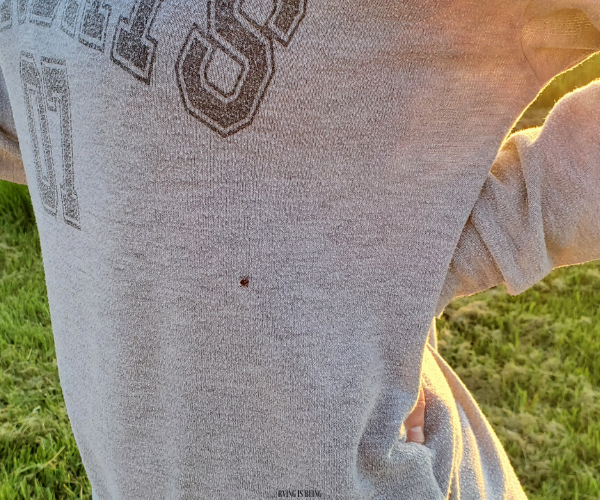
Use Repellents and Insecticides
To reduce the chance of being bit, use EPA (Environmental Protection Agency) registered insect repellents. For instance, products containing DEET, picaridin, IR3535, and Oil of Lemon Eucalyptus can help deter ticks.
Accordingly, the CDC recommends using products with 20% DEET. Check out the full list of active ingredients in EPA-registered skin applied insect repellants, here, and use the EPA’s search tool to help find the product that best suits your needs. In fact, there’s hundreds of products you can search– by the active ingredient, hours of protection you need, or by the company. Remember to always follow product instructions and consult your doctor before using any repellents or insecticides on you or your children.
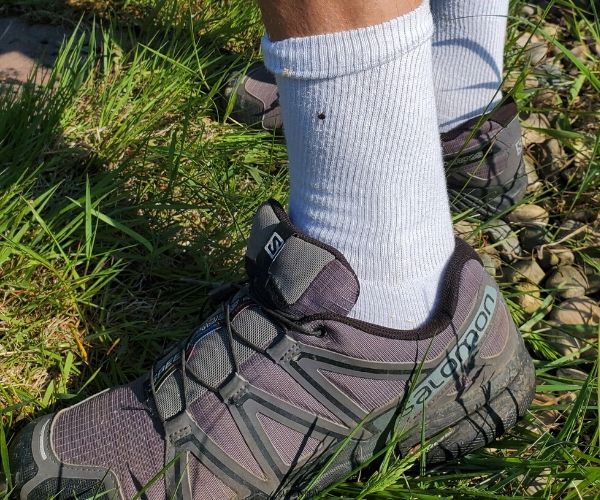
Treat clothing, shoes, backpacks, tents, and other gear with products containing 0.5% permethrin. Permethrin is an insecticide that protects you from mosquitos and tick bites. It will actually kill ticks rather than just repel them. Spray clothing according to the directions as well as follow the care instructions. Never apply permethrin to the skin.
On the same topic, permethrin treatments can last multiple washings so that you don’t have to treat clothing or gear every time you visit tick habitats.
Protect Your Pet
Lyme disease can affect our furry family members too. Make sure your pet is on a monthly tick prevention medication or wears a tick collar. As a matter of fact, be sure to ask your vet what products are right for your avid camping family.
Also, try to keep your pet on a leash to prevent them from running off the trail and into overgrown areas where ticks are most present.

Do a Tick Check
Thoroughly check yourself and children. Check the entire body and pay special attention to the scalp, around ears, under arms, belly button, groin area, and behind the knees. Although larger ticks can be easier to spot– some can be as little as a poppyseed. Make sure to check everywhere— and double check those freckles!
Don’t forget your pets! Ticks can appear anywhere on a pets body, so it is extremely important to take the time and thoroughly look your pets over. In fact, just because they are on tick prevention doesn’t mean you can skip checking them over. Ticks can quickly transfer from them into the camper or on to you!
After Outdoor Excursions
- If you can, try to change clothes after long periods outside.
- After a long hike or day outside, it’s wise to wash your clothing. Now, it’s hard enough keeping up on laundry at home, let alone while camping. However, if a laundry facility is available and at the very least, throw clothing in a dryer on high heat to kill any remaining ticks. If laundry has to wait until you get back home from vacation– put dirty clothes into a tightly sealed trash bag.
- Ticks can be extremely tiny and hard to see. Use a sticky, lint roller over clothing to pick up any loose ticks.
- Try to take a shower soon after coming indoors. This is a great time to wash off any unattached ticks and thoroughly check for any others.
What to do for a Tick Bite
I’m sure you’ve heard about the nail polish hack… the lit-match trick, OR the PETROLEUM JELLY METHOD….
Now, who in the tarnation finds a tick BURROWED into their flesh and has the self-restraint to calmly slab some petroleum jelly on that blood-sucking critter while patiently WAITING for it to back out with a full belly?!
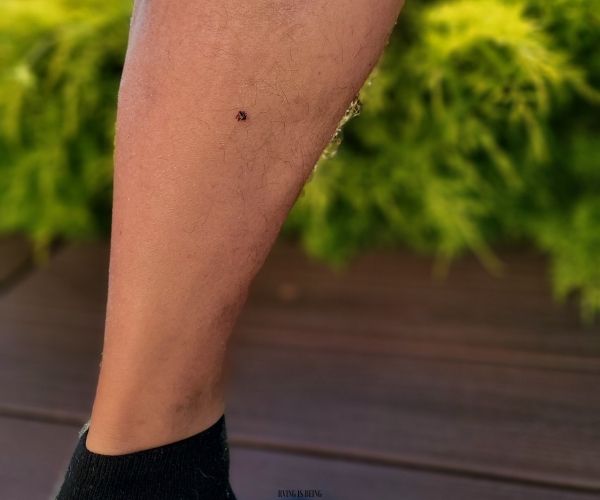
There’s NO patiently waiting for a disease carrying parasite to escort themselves from underneath my skin…
Likewise, who’s idea was it to burn its bottom with a hot match in hopes it’ll back out?
Put the vaseline, matches, and nail polish away. Get a pair of good ‘ol tweezers and PULL THAT SUCKER OUT!
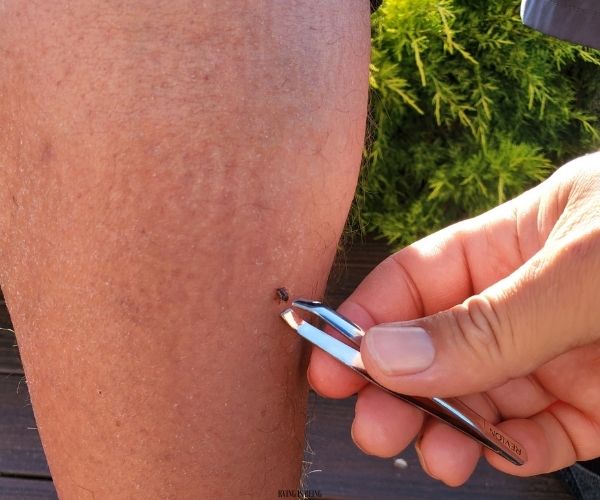
In detail, calmly take tweezers, grasp the tick as close to the skin as possible, and gently pull the tick out– without jerking or twisting its body so that no tick parts are left inside your skin.
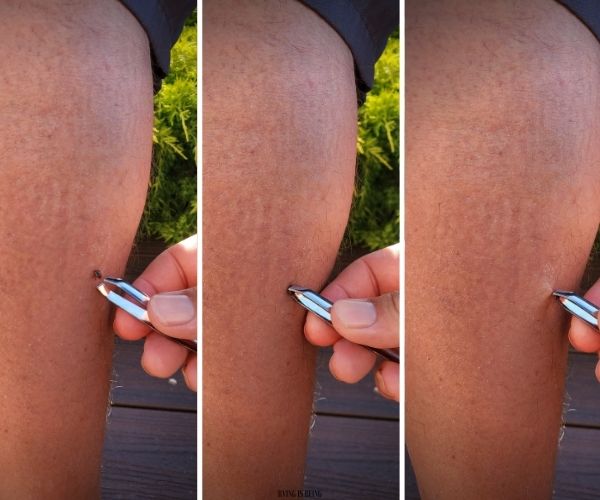
It’s wise to save the tick– if you can somehow– perhaps sealed in a plastic baggy or in a small jar. Consult your physician or veterinarian (if found on your pet) and provide them the culprit, should you or your pet feel unwell, break-out in a rash, or develop any other symptoms. Many times, ticks will get sent out to a lab to be tested of any harmful pathogens.
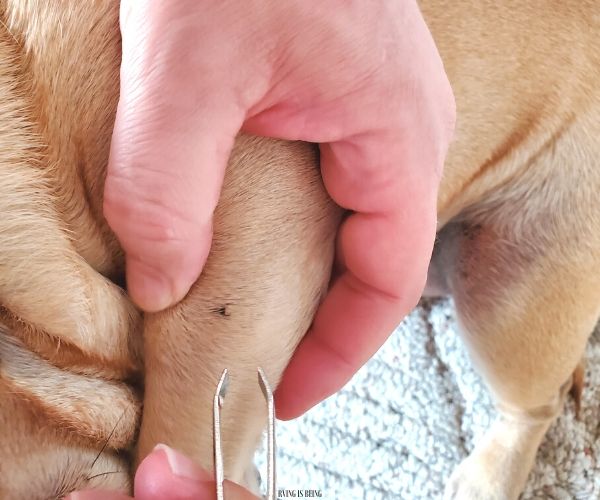
In Summary
- Try to pick a clear, groomed campsite that is not overgrown with thick brush or tall grass.
- Choose cleared walking paths. Try to stick to trail centers and not brush up on overgrown edges.
- Wear long clothing to cover your arms and legs. Don’t forget to tuck it in!
- Use repellents and insecticides. It’s important to consult your doctor or veterinarian first before using.
- Protect your pet by keeping them close and not free to run in overgrown areas. Also, make sure they are current on tick prevention.
- Frequently do a tick check on yourself, children, and pets.
- Take a shower after long durations outdoors.
- Wash clothing. If laundry facilities are not present, contain dirty clothing in a tightly sealed trash bag until you get home.
- Remove ticks as soon as possible with tweezers or a proper tick removal tool.
Don’t forget! Add these items to your next camping trip!
- Pointed tweezers/tick kit
- Sticky lint roller
- First Aid kit
- Insect/tick repellent
- Tall boots and long clothing
- Permethrin treated clothing and gear
- Tick prevention for pets/make sure they are current
Camping is about exploring and simply being in the great outdoors. We don’t always stick to cleared trails or select immaculately maintained RV resorts. In fact, some of the best memories come from adventuring away from the campsite, exploring the untravelled paths, and experiencing our wild surroundings.
With that being said, you don’t have to sacrifice experiences– just be aware and use preventative measures through your camping excursions!
RVING IS BEING tick-cautious. Not ticked-off.
Related posts
Today's pick
Hot topics
Disclosure: This website contains affiliate links, meaning we will get a commission if you decide to make a purchase through the links, at no additional cost to you. Additionally, this website is an Amazon Associate. As an Amazon Associate, the owner of this website earns a commission as a result of certain qualifying purchases. CERTAIN CONTENT THAT APPEARS ON THE SITE TO WHICH THIS SITE LINKS ARE AFFILIATE LINKS. THIS LINKED CONTENT IS PROVIDED “AS IS” AND IS SUBJECT TO CHANGE OR REMOVAL ANY TIME. Please read this Site’s disclosure and privacy policy & terms for more information.
Categories
- Children & Family (15)
- Cookout Gear & Accessories (6)
- Food (2)
- Guide (37)
- Health (5)
- Holidays (10)
- List (10)
- Maintenance & Repair (10)
- Printables (4)
- Products & Accessories (40)
- Quote (3)
- RV & Campsite Setup (23)
- RVING (78)
- Shop Page (36)
- Storage & Organization (2)
- Tech (4)
- Travel (22)







